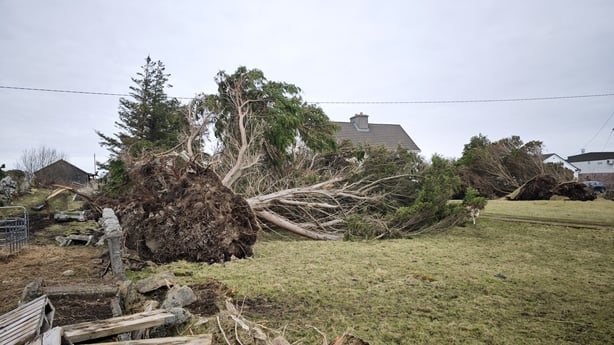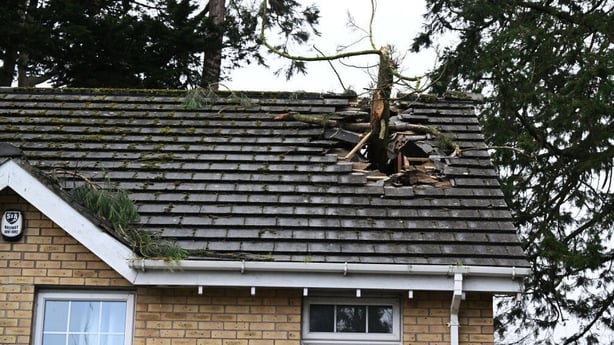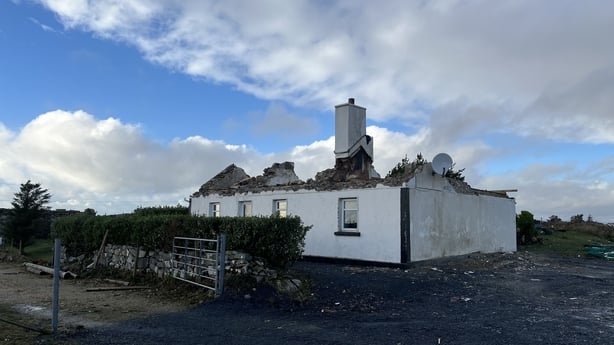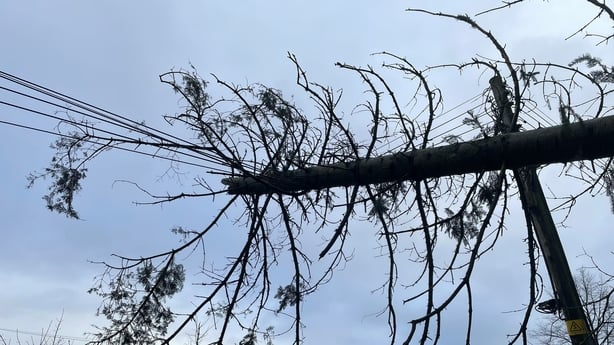Storm Éowyn was a real eye opener about the damage an extreme weather event can cause in Ireland.
It highlighted key vulnerabilities in electricity, water, and telecommunications.
It underscored, like no other event has done in recent times, how the resilience of all our critical infrastructure is interdependent and interconnected.
When one went down, they all went down.
It was a cascade of failures that disrupted lives and livelihoods and devastated communities.

Climate expert, Professor Conor Murphy of Maynooth University, said we really need to learn the lessons from the storm.
"We need to make sure we know what the needs are, so that people aren't discommoded for long periods of time."
Prof Murphy also said that he is left wondering about the further impact it has had on people and communities.
He is thinking about households with small babies and people with critical illnesses whose medications needed to be kept in a fridge.
"There are ongoing health and wellbeing impacts for people and it isn't finished yet," he says.
Emergency planning
Prof Murphy claims one key lesson from the storm is that the Government needs to engage more with the public in emergency planning.
He argues that far greater clarity is required about what people need to do and about logistics during an emergency like that.
People need to know how they can avail themselves of the resources needed to get back on their feet.
"We talk about resilience and have a national objective of having a climate resilient Ireland by 2050. But the evidence from Storm Éowyn shows us we're not there yet.

"Resilience is not just about the speed of recovery of an electricity system. It needs to include people, and communities, and the social support required for the most vulnerable within those communities. We need to make sure we know what the needs are, so that people aren't discommoded for long periods of time," he said.
Prof Murphy argued that it is not just the initial response to an extreme weather event that needs attention. It is the recovery period afterwards too.
"I remember from floods in 2009 doing work with communities affected. Six to eight months after those floods, they were still trying to deal with insurance," he said.
Prof Murphy added: "I'm hoping it will be far more efficient this time, and people won't be left dealing with insurance companies for months because that also has negative impacts for health and wellbeing in the communities affected."
Claims cost
It is just four weeks since Storm Éowyn hit. So far almost 24,000 insurance claims have been lodged. Two thirds of the claims have been lodged by homeowners.
Insurance Ireland, which represents the industry, said the claims cost so far is running at €197 million. But it is still rising, and it is not beyond the bounds of possibility that it could reach €300m before it's over.
If it goes that high, Storm Éowyn would become one of the most expensive extreme weather events ever in Ireland.
Fifteen years ago, in January 2010, the insurance industry had to fork out €297 million to settle claims related to the coldest winter for 50 years.
That’s the same as €385 million in today’s money. This means, in real terms, the cold was actually more damaging than the windstorm.

The same is true of the severe flooding experienced in 2009. That cost the insurance sector €244 million in claims, equivalent to €313 million in today’s money.
Claims related to another severe cold spell in December 2009 cost €224 million, equal to €285 million in 2025.
Those figures suggest that periods of severe cold and flooding are capable of inflicting potentially more costly damage to private property and private infrastructure than hurricane-force winds.
The same, however, may not be true for public infrastructure because there is no question that the damage and disruption to electricity, water and telecommunications was on a scale never experienced here before.
'We knew it was going to be serious' - ESB
Regional manager at ESB Networks Siobhán Wynne said she was shocked by the impact of the storm.
"There was damage to ESB’s high voltage network. Some of its tallest and strongest pylons, through which the highest power load is delivered to the large urban centres, were unable to withstand winds as strong as 183km/h. It was unprecedented.
"Very early on, we knew it was going to be serious. We sought help. Our contracting partners were on the ground from day zero, but also assistance from other colleagues from seven different countries.
"Almost 700 crew members came in. They came from Britain, from Austria, France, Germany, Finland, Norway and Northern Ireland. We have never had to call in that kind of assistance before," she said.
At the height of the storm, ESB had 3,200 people on the ground working on repairs. A further 1,300 people were in offices and depots assisting them.

There was an enormous amount of logistics to be sorted out.
"If you bury a power line underground, and then there is a fault, it will be far, far harder to actually get at it and resolve it."
Local authorities helped to clear roads and remove damaged trees. Six Air Corp helicopters worked from the air to survey the damage and help ESB to isolate faults.
More than 1,100 hotel rooms and B&Bs had to be found so repair crews, dispatched all over the country, had a bed for the night after a long, hard day's work.
By the time it was all over ESB had replaced over 3,700 electricity poles, 700km of conductor wire, and 800 electricity transmitters.
It used 50 forest harvesters, fielded 260,000 calls from customers, and had 11.7 million views on its PowerCheck app.
Ms Wynne described it as a great team effort.
"I think we learned that we can deal with these situations. We will obviously conduct a full review after this, as we would always, and there could be other learnings that we will get from that," she said.
All that effort and disruption has caused many to wonder if it is now time to put our overhead electricity wires under the ground. Ireland has four times more overhead wires per capita than the UK or other European countries.
Surely the disruption from windstorms would be a thing of the past if our overhead electricity wires were buried instead.
Neither practical nor economic
However, Professor Peter Thorne, chair of climate adaptation on the Climate Change Advisory Council, said that burying electricity wires is neither practical nor economic.
"First and foremost, if you bury a power line underground, and then there is a fault, it will be far, far harder to actually get at it and resolve it," he says.
"There are underground power lines in much of the country and in many of the urban centres. That's absolutely necessary and advisable.
"But in rural areas, particularly in very remote dwellings, undergrounding kilometres of cable for just one remote property? Economically, that makes no sense.
"You can pay for that property to have solar panels. You can put an islanding switch that makes it possible for it to be off the electricity grid. You could put tens of kilowatts of batteries storage capacity in place. That would be far, far cheaper than underground cables."
Prof Thorne said there is no one-size-fits-all solution to ensure the resilience of electricity supply for small communities.
One possibility could be a community battery and the ability for individual properties to separate from the electricity grid.

"Imagine you got a 40-kilowatt hour battery from an upcycled electric vehicle that you can charge very cheaply overnight using the dynamic electricity pricing tariffs and use it during the day.
"It would pay for itself in two or three years and your electricity supply would be resilient. Whenever the electricity goes out, you will still have 40 kilowatts of power," he said.
Bad and all as Storm Éowyn was, Keith Lambkin, head of Climate Services at Met Éireann, said there could be worse impacts for humans from other types of extreme weather events in the future.
He said a warmer atmosphere carries more moisture. So, we expect to see more heavy rainfall events causing destruction.
"You get an awful lot of economic damage from rainfall events. But when it comes to mortalities, when it comes to people dying, excessive heat is the biggest killer by far," he said
Mr Lambkin added: "Heat stress, particularly in the elderly and the vulnerable, is where we see the biggest level of deaths.
"A study from last year right across Europe, saw an order of magnitude of 50 to 60 people died due to windstorms.
"There was a similar number related to rainfall, but tens of thousands of deaths were caused by heat stress in the elderly and vulnerable population. That is really the big danger here as well," he said.
We need your consent to load this rte-player contentWe use rte-player to manage extra content that can set cookies on your device and collect data about your activity. Please review their details and accept them to load the content.Manage Preferences








